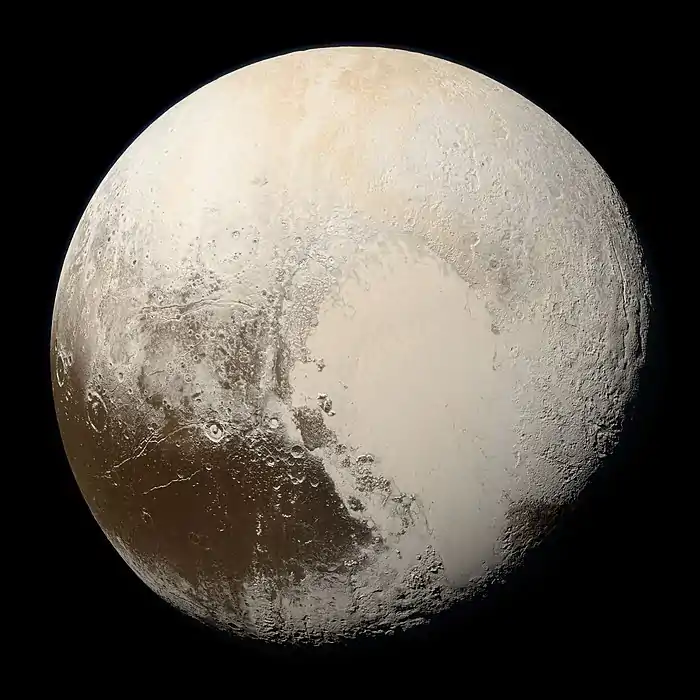 Hubble Space Telescope image of 2001 UR163 taken in 2005 | |
| Discovery[1][2] | |
|---|---|
| Discovered by | DES |
| Discovery site | Kitt Peak National Obs. |
| Discovery date | 21 October 2001 |
| Designations | |
| (42301) 2001 UR163 | |
| 2001 UR163 | |
| TNO[3] · 4:9 res[4][5] distant[1] | |
| Orbital characteristics[3] | |
| Epoch 1 July 2021 (JD 2459396.5) | |
| Uncertainty parameter 2[1][3] | |
| Observation arc | 38.45 yr (14,045 d) |
| Aphelion | 66.643 AU |
| Perihelion | 36.987 AU |
| 51.815 AU | |
| Eccentricity | 0.2862 |
| 372.98 yr (136,232 d) | |
| 80.814° | |
| 0° 0m 9.36s / day | |
| Inclination | 0.7531° |
| 301.39° | |
| 8 October 1937 | |
| 344.50° | |
| Physical characteristics | |
Mean diameter | 352±85 km[4][6]: 26 |
| 0.209±0.08[4][6] | |
| 21.3[9] | |
| 4.21[1][3] | |
(42301) 2001 UR163, prov. designation: 2001 UR163, is a resonant trans-Neptunian object and possible dwarf planet located in the outermost region of the Solar System. The object measures approximately 352 kilometers (220 miles) in diameter with a high albedo and stays in an uncommon orbital resonance (4:9) with Neptune. It was discovered on 21 October 2001 by astronomers of the Deep Ecliptic Survey program at Kitt Peak National Observatory near Tucson, Arizona, United States. As of 2021, it has not been named.[1]
Classification and orbit
2001 UR163 has been characterized as a dwarf planet candidate.[10] Based on assumptions and estimates, Michael Brown gives it a "likely"-status on his website, which is the third highest status after "near certainty" and "highly likely" (also see his classification table).[11]
The object orbits the Sun at a distance of 37.0–66.6 AU once every 372 years and 12 months (136,232 days; semi-major axis of 51.82 AU). Its orbit has an eccentricity of 0.29 and an inclination of 1° with respect to the ecliptic.[3] It came to perihelion on 8 October 1937, and has since been moving away from the Sun.[3] In 2006, it moved beyond a distance of 50 AU and is at 53.7 AU as of 2021.[9] The body's observation arc begins with a precovery, published by the Digitized Sky Survey and taken at the Siding Spring Observatory in July 1982.[1]
Numbering and naming
2001 UR163 was numbered (42301) by the Minor Planet Center on 26 May 2002 (M.P.C. 45686).[12] As of 2021, it has not been named.[1] Acoording to the established naming conventions, it will receive a mythological or mythic name (not necessarily from Classical mythology), in particular one associated with creation.[13]
Physical characteristics
Lightcurve analysis shows only small deviations, suggesting that 2001 UR163 is a spheroid with small albedo spots.[10] Observations with Spitzer's Infrared Array Camera were used to study the body's surface composition. The analyzed data indicate the presence of 20% water ice, 60% amorphous silicates, and 20% organic compounds, including complex ones such as tholins.[6]: 20
Diameter and albedo
2001 UR163 measures approximately 352 kilometers (220 miles) in diameter with a high albedo of 0.209.[4][6]: 26
Based on previous estimates published on the Lightcurve Data Base and on Michael Brown's website, 2001 UR163 measures between 531 km (330 mi) and 583 kilometers (360 miles), using an assumed intermediate surface albedo of 0.09 to 0.10 with an absolute magnitude of 4.49 and 4.4, respectively.[7][11]
See also
References
- 1 2 3 4 5 6 7 "42301 (2001 UR163)". Minor Planet Center. Retrieved 27 July 2021.
- ↑ Marsden, Brian G. (14 November 2001). "MPEC 2001-V57: 2001 QX322, 2001 UR163, 2001 VN71". IAU – Minor Planet Center. Minor Planet Electronic Circulars. Archived from the original on 11 April 2010. (K01UG3R*)
- 1 2 3 4 5 6 "JPL Small-Body Database Browser: 42301 (2001 UR163)" (2021-01-08 last obs.). Jet Propulsion Laboratory. Retrieved 27 July 2021.
- 1 2 3 4 Johnston, Wm. Robert (18 August 2020). "List of Known Trans-Neptunian Objects". Johnston's Archive. Retrieved 27 July 2021.
- ↑ Marc W. Buie. "Orbit Fit and Astrometric record for 42301". SwRI–Southwest Research Institute. Retrieved 27 July 2021.The Deep Ecliptic Survey Object Classifications
- 1 2 3 4 5 Fernández-Valenzuela, E.; Pinilla-Alonso, N.; Stansberry, J.; Emery, J. P.; Perkins, W.; Van Laerhoven, C.; et al. (February 2021). "Compositional Study of Trans-Neptunian Objects at λ > 2.2 μm". The Planetary Science Journal. 2 (1): 10. arXiv:2011.07121. Bibcode:2021PSJ.....2...10F. doi:10.3847/PSJ/abc34e. ISSN 2632-3338. S2CID 234003733.
- 1 2 "LCDB Data for (42301)". Asteroid Lightcurve Database (LCDB). Retrieved 27 July 2021.
- 1 2 3 4 Belskaya, Irina N.; Barucci, Maria A.; Fulchignoni, Marcello; Dovgopol, Anatolij N. (April 2015). "Updated taxonomy of trans-neptunian objects and centaurs: Influence of albedo". Icarus. 250: 482–491. Bibcode:2015Icar..250..482B. doi:10.1016/j.icarus.2014.12.004.
- 1 2 "Asteroid (42301) 2001 UR163 – Ephemerides". AstDyS-2, Asteroids – Dynamic Site, Department of Mathematics, University of Pisa. Retrieved 27 July 2021.
- 1 2 Tancredi, Gonzalo; Favre, Sofía (June 2008). "Which are the dwarfs in the Solar System?" (PDF). Icarus. 195 (2): 851–862. Bibcode:2008Icar..195..851T. doi:10.1016/j.icarus.2007.12.020. ISSN 0019-1035.
- 1 2 Michael E. Brown. "How many dwarf planets are there in the outer solar system? (updates daily)". California Institute of Technology. Retrieved 31 August 2016.
- ↑ "MPC/MPO/MPS Archive". Minor Planet Center. Retrieved 27 July 2021.
- ↑ "Naming of Astronomical Objects – Minor planets". IAU – International Astronomical Union. Retrieved 27 July 2021.
External links
- List Of Centaurs and Scattered-Disk Objects, Minor Planet Center
- The Meudon Multicolor Survey (2MS) of Centaurs and Trans-Neptunian objects
- TNO Colors
- KBO Surface Colors
- Red Planetoid Sedna covered in tar-colored sludge
- Asteroid Lightcurve Database (LCDB), query form (info Archived 16 December 2017 at the Wayback Machine)
- Discovery Circumstances: Numbered Minor Planets (40001)-(45000), Minor Planet Center
- (42301) 2001 UR163, Small Bodies Data Ferret
- (42301) 2001 UR163 at AstDyS-2, Asteroids—Dynamic Site
- (42301) 2001 UR163 at the JPL Small-Body Database
_(cropped).jpg.webp)
